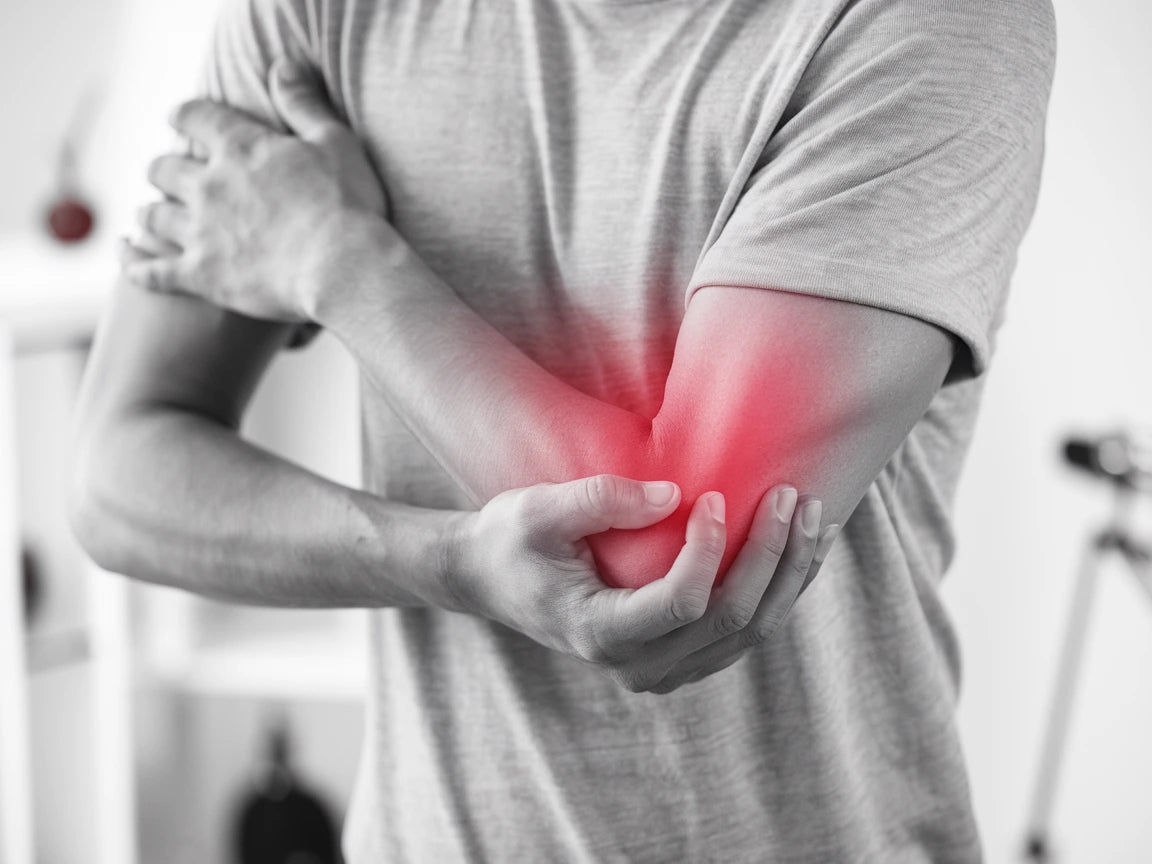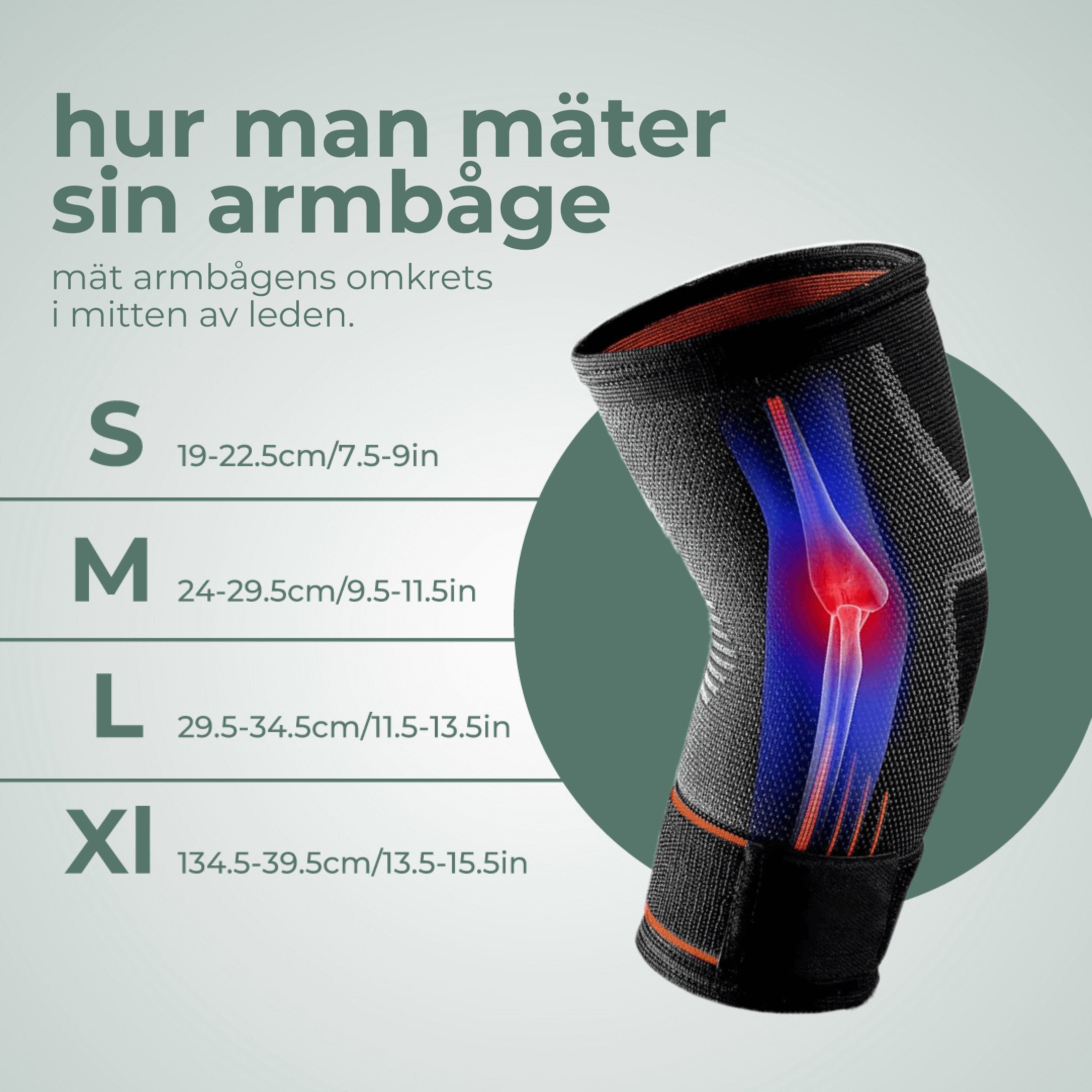Bursitis in the Elbow: Symptoms, Causes, and Treatment

Elbow bursitis, also known as olecranon bursitis or "student's elbow," is a painful inflammation of the bursa located over the elbow joint. This article covers the most common symptoms, causes, and treatment options for elbow bursitis.
What is Elbow Bursitis?
Elbow bursitis is an inflammation of the fluid-filled bursa at the elbow joint, causing pain, swelling, and reduced mobility. Treatment includes rest, anti-inflammatory medications, and physical therapy.
Bursae, also known as bursas, are small fluid-filled sacs that act as cushions between bones, tendons, joints, and muscles. They reduce friction and facilitate movement. When a bursa becomes inflamed, as in elbow bursitis, it swells and leads to pain and limited mobility in the affected area.
Symptoms of Elbow Bursitis
Bursitis in the elbow can manifest in several ways, and the symptoms may vary in intensity. Common symptoms include:
- Swelling over the elbow: This is often the most visible sign of bursitis. The swelling can be soft and fluid-filled or hard and firm.
- Pain and tenderness: The elbow may be painful to touch and during movement, especially when bending or straightening the arm.
- Redness and warmth: The affected area may become red and feel warm to the touch, which are signs of inflammation.
- Limited mobility: Due to pain and swelling, it may become difficult to fully bend or straighten the elbow.
- Stiffness: The elbow may feel stiff, especially in the morning or after longer periods of inactivity.
Bursitis in the elbow differs from other types of elbow pain, such as impingement, because swelling is often visible and localized at the back of the elbow. In some cases, particularly if an infected bursa is involved, more severe symptoms like fever and increased redness may occur, necessitating prompt medical attention.
Causes of Elbow Bursitis
Several factors can contribute to the development of bursitis in the elbow:
- Repeated pressure or trauma: Frequently resting your elbows on hard surfaces or subjecting them to repeated impacts can irritate the bursa.
- Overuse: Repetitive movements or overuse of the elbow can lead to inflammation.
- Infection: In some cases, bacteria can enter the bursa causing infectious bursitis.
- Underlying conditions: Conditions such as rheumatoid arthritis or gout can increase susceptibility to bursitis.
- Occupation or hobby: Certain professions or activities that require extensive use of elbows may raise risk levels.
Individuals who frequently lean on their elbows or work in jobs that require lying on them (such as plumbers or auto mechanics) are at greater risk for developing bursitis. Structures around the elbow may also be affected, sometimes leading to complications involving muscles extending from the elbow up towards the shoulder blade.< / p >
Diagnosis and Treatment of Elbow Bursitis
To effectively treat elbow bursitis, it is important to obtain a correct diagnosis and choose the right treatment method:
| Behandlingsmetod | Beskrivning | Fördelar med Armbågsstöd och Termorelieve™ |
|---|---|---|
| Vila och avlastning | Minska belastningen på armbågen | Armbågsstödet ger stöd och påminner om korrekt position |
| Kyl- och värmeterapi | Lindrar smärta och inflammation | Termorelieve™ erbjuder både kyl- och värmeterapi |
| Antiinflammatoriska läkemedel | Minskar inflammation och smärta | Kan minska behovet av medicin genom naturlig lindring |
| Fysioterapi | Övningar för att återfå rörlighet och styrka | Armbågsstödet stödjer under övningar |

How Elbow Supports and Termoreliever™ Can Help with Elbow Bursitis
Elbow Support and Termoreliever™ offer several benefits for individuals suffering from elbow bursitis:
- The elbow support provides stability and relief to the affected elbow, which can reduce pressure on the inflamed bursa.
- Termoreliever™ offers both cold and heat therapy, which is essential for managing inflammation and pain. Cold therapy can be used in the acute phase to reduce swelling, while heat therapy can be applied later to increase blood circulation and promote healing.
- The combination of these products can help accelerate recovery by providing continuous support and pain relief.
- The products can be customized to individual needs and used during both rest and light activity.
For individuals with recurring issues of elbow bursitis, these aids can be particularly valuable in preventing new episodes by alleviating pain and reducing strain on sensitive bursae.
Conclusion
Bursitis in the elbow can be a painful and limiting condition, but with the right diagnosis and treatment, most individuals can experience significant improvements. By combining traditional treatment methods with innovative aids such as Elbow Supports and Termoreliever™, many can effectively manage their symptoms and regain normal function in the elbow. It is important to listen to your body's signals and seek professional help if symptoms are persistent or worsen.
For optimal recovery, it is crucial to treat both the acute inflammation and identify the underlying causes to prevent recurrence. With the right combinations of treatments and preventive measures, most individuals can return to normal activities without long-term issues.
Frequently Asked Questions (FAQ)
How long does elbow bursitis usually last?
With the right treatment, many can experience improvement within a few weeks. However, some cases may take longer, up to several months, depending on the severity.
Can I exercise with bursitis in my elbow?
Light exercise and specific workouts can often be part of the treatment, but it is important to avoid activities that worsen the pain. Consult a physiotherapist for a tailored exercise program.
How do I use Termoreliever™ for elbow bursitis?
Use cold therapy in the acute phase to reduce inflammation, typically for 15-20 minutes at a time, several times a day. Then switch to heat therapy to promote healing and increase mobility.
Can the elbow support prevent bursitis in the elbow?
Yes, by providing support and reducing pressure on the elbow, the Elbow Support can help prevent overuse and reduce the risk of bursitis, especially during activities that strain the elbow.
When should I seek medical care for bursitis in the elbow?
Seek medical care if the pain is intense, if you have significant swelling or redness, if you have a fever, or if the symptoms do not improve after a few days of self-care.
